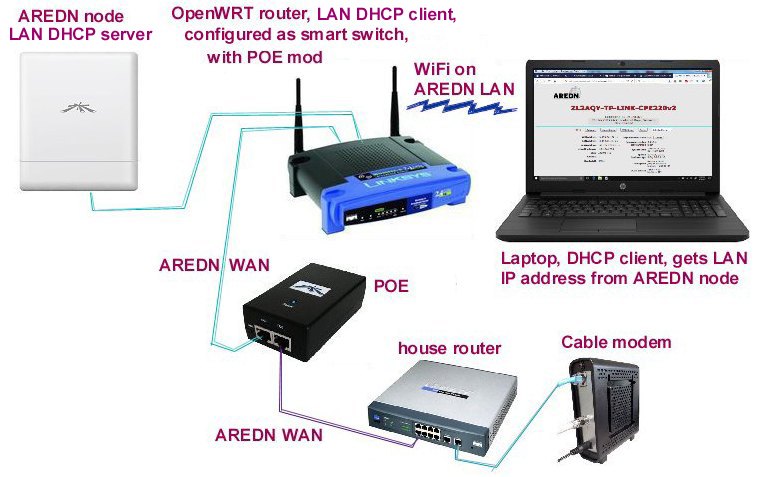| Using an OpenWRT router to provide multiple ports to an AREDN node that has a single POE network port |

| Using an OpenWRT router to provide multiple ports to an AREDN node that has a single POE network port |

Goal is to use an OpenWRT router to support a Bullet or an M900, instead of a Netgear Smart switch. Details follow.
On this OpenWRT router I went to its "switch" tab. And then I created an independent VLAN (VLAN 2, for DtD) that the main LAN (VLAN 0) won't "see" except inside the AREDN node. VLAN 1 will be the node's WAN (but do not confuse this WAN with the OpenWRT router's WAN). Okay, what did this get me as far as AREDN goes? These ports and VLANs will do the same thing we have Netgear smart switches doing. As most of us have WRT54Gs laying around... One port to feed the Bullet, another becomes the WAN for the Bullet, another the DtD port and others becomes the Bullet's LANs.
One thing to remember! Be sure you have the CPU "port" accessible to the Bullet's LAN, else you won't be able to reach the OpenWRT web GUI again!
Here is how we, in the OpenWRT router's GUI page for its switch (under Network and then under
Switch), made an OpenWRT
router act like a Netgear
smart switch to service an AREDN node with just one ethernet jack,
like a Bullet, to split off its WAN, LANs and DtD signals. At the switch tab, set things as below:

To set the OpenWRT router's LAN to be a DHCP client of the AREDN node, go in the OpenWRT web GUI for its LAN (under Network, then under Interfaces, and then click "edit" to the right of the LAM graphic box), and set it to be a DHCP client. The AREDN node will be the DHCP server. Don't do anything with the router's WAN here, it's not used (as we turned VLAN 1 off in the CPU port, this disconnects the OpenWRT router's WAN from this VLAN and thus from port 1).
If desired, the OpenWRT router's WiFi can be used as an AP to connect devices to the LAN. These devices will get their IP addresss (set the devices to be a DHCP client) from the Ubiquiti node. This is the non-ham radio FCC part 15 Wifi 802.11b/g. Go to the OpenWRT router's WiFi setup page, under "network" and then "wifi" to set it up as usual. under "Interface Configuration" (scroll down the eifi page a little) and then "network", you can select the network you want to attach to this wireless interface, likely already set to LAN.
Of course this is meaningful only if you happen to have some OpenWRT routers (like WRT54G's) laying around.... This OpenWRT router (a WRT54G V2.2) as a Netgear smart switch has worked fine 3 months now without any issues.

I did an additional mod to it, to have it run off the Ubiquiti POE power supply, and pass the POE to also power the Ubiquiti M900 node. I connected jumper wires between the ethernet jacks that are for the node, and the WAN connection, the blue and brown twisted pairs. Remove 75 ohm resistors RD13 and RD1, as these would introduce an unneeded extra load on the POE. And from the brown jumper wire I connected via a 5V 5W Zener diode to the router's ground, and from the blue jumper (the positive supply) a regular rectifier diode to the router's power rail (the WRT54G V2,2 uses a diode from the power jack to the internal power rail (protection from backwards wall warts, and here it keeps the POE from feeding into any Linksys wall wart that might still be plugged in the router)). As the router's internal DC-DC converters are rated a max of 24VDC, and the Ubiquiti POE brick produces 24VDC, I used these diodes to knock this 24V to 18V inside the router. I didn't want to run the converter chips on the edge... I attached some heat sinking to the Zener diode, on its leads I soldered some pieces of copper clad circuit board, it runs cool. The Ubiquiti POE brick has no problem with the extra load. And this means one less 120V brick in the shack.

